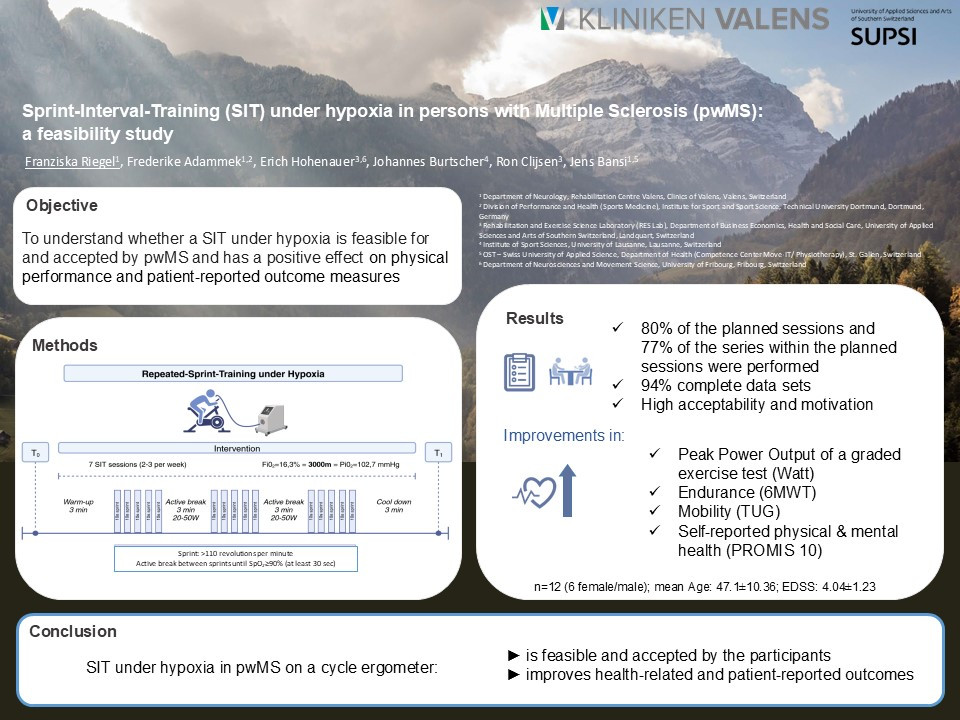Background
High-intensity interval training modalities are time-effective and have positive effects on various MS symptoms like walking impairment, fatigue and MS-related performance impediments (cardiorespiratory fitness). Exercise under hypoxic conditions induces comparable training effects to exercise performed under normoxic conditions with the required workloads being significantly lower to achieve these effects. Lower workloads under hypoxic conditions are beneficial for persons with multiple sclerosis (pwMS) especially when fatigue or reduced mobility prevents pwMS from exercising with higher workloads. This study investigates the feasibility of a sprint interval training (SIT) on a cycle ergometer under hypoxic conditions in pwMS.
Methods
Ten pwMS (Relapsing-Remitting phenotype) participated in seven SIT sessions (3 per week) under normobaric hypoxia, equivalent to an altitude of 3000 m above mean sea level. All training sessions took place in addition to the standard rehabilitative care during a three-week inpatient stay at the Valens clinic, Valens, Switzerland. SIT was performed on a cycle ergometer while participants wore masks that covered mouth and nose, connected to the hypoxic generator via tubes. Heart rate (measured via Bluetooth chest belt) and oxygen saturation (SpO2; measured via an ear clip non-invasive fibre optic pulse oximeter) were constantly monitored during the sessions. SIT sessions consisted of 3 min warm-up followed by three series of five sprints à 10 s (with maximal possible revolutions per minute, rpm) with an active rest of at least 30 s between the sprints and 3 min between the series and ended with 3 min cool-down. Warm-up, active rest and cool down were performed with 20-50 Watts (60-80 rpm). When SpO2 decreased during or after a sprint below 90%, active rest was prolonged until oxygen saturation was ≥ 90%.
Primary outcomes were feasibility of the study protocol (>70% of participants completing >70% of planned sessions) and data collection (>70% of complete data sets), and acceptability of the intervention from the participants’ perspective (measured via semi-structured interviews). Secondary outcomes were Peak Power Output (PPO) of a graded exercise test (Watts, Watts/kg), 10 Meter Walk Test (10MWT), Two Minute Walk Test (2MWT), Six Minute Walk Test (6MWT), Timed Up and GoTest (TUG) and Patient Reported Outcomes Measurement Information System Questionnaire mental and physical score (PROMIS mental/physical) at baseline (T0) and discharge after three weeks (T1). Wilcoxon's signed rank test was conducted to analyse the changes between T0 and T1 in these parameters. Semi-structured interviews (conducted at T1) covered perceptions of participants’ physical reactions to SIT, their attitude and motivation towards SIT and the procedures of the SIT sessions.
Results
The study protocol was feasible with 80% of the recruited participants completing 79% of the planned series within the scheduled sessions. 88% of the data collection was successfully achieved. Results of the interviews show a high acceptability and motivation of the participants towards SIT, all participants would participate in a SIT again. Wilcoxon’s signed rank tests revealed significant improvements from T0 to T1 in the following outcomes: a significant increase in PPO (p=0.046), 2MWT (p=0.008), 6MWT p=0.005), PROMIS mental (p=0.042), PROMIS physical (p=0.042) and a significant decrease in TUG (p=0.048).
Conclusion
SIT under hypoxia in persons with MS on a cycle ergometer is feasible, accepted and positively evaluated by the participants, and improving patient-reported and health-related outcomes.
Keywords
Endurance training, hypoxia; Multiple Sclerosis; PROMS, high-intensity
